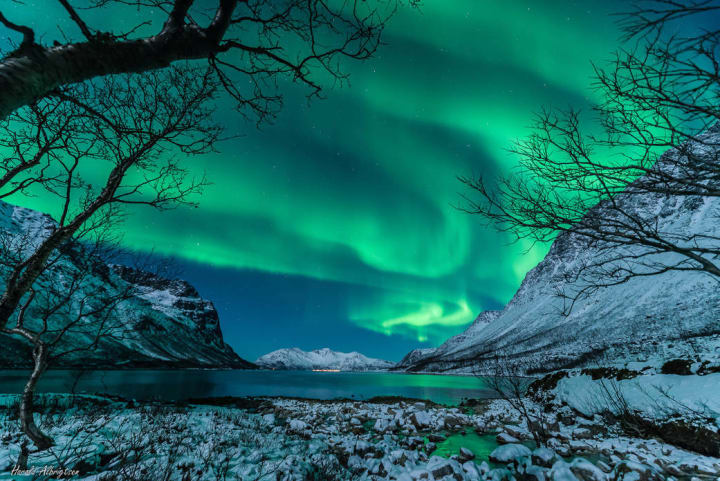AURORAS
Celestial Dancers of the Polar Skies

Auroras, also known as the Northern Lights (Aurora Borealis in the Northern Hemisphere) and the Southern Lights (Aurora Australis in the Southern Hemisphere), are stunning natural light displays that occur in the polar regions of the Earth. They are caused by interactions between charged particles from the solar wind and the Earth's magnetosphere and atmosphere.
Here's how the process works:
Solar Wind: The Sun continuously emits a stream of charged particles called the solar wind. These particles travel through space and can take about 2 to 4 days to reach the Earth.
Earth's Magnetosphere: The Earth has a magnetic field that surrounds it, called the magnetosphere. When the solar wind particles approach the Earth, they are deflected by this magnetic field.
The Interaction: Some of the solar wind particles get trapped in the Earth's magnetosphere and are guided towards the polar regions, specifically the areas around the magnetic poles.
Atmospheric Excitation: As the solar wind particles collide with the gases in the Earth's atmosphere, such as oxygen and nitrogen, they transfer energy to these atoms and molecules.
Light Emission: The energized atoms and molecules in the atmosphere then release the energy in the form of light. The colors of the auroras depend on the type of gas and the altitude at which the collisions occur. Oxygen typically produces green and red auroras, while nitrogen produces purple and blue auroras.
Auroral Oval: The auroras tend to form an oval shape around the magnetic poles. In the Northern Hemisphere, they are usually visible in areas near the Arctic Circle, such as Alaska, Canada, Norway, and Sweden. In the Southern Hemisphere, they are visible near the Antarctic Circle, although they are not as easily accessible due to the remote and harsh environment.
Auroras are one of the most breathtaking and awe-inspiring natural phenomena on Earth. They can appear as shimmering curtains, arcs, or even spirals of light dancing across the night sky. The intensity and frequency of auroras depend on solar activity, with periods of high solar activity, such as during solar storms or solar flares, leading to more vibrant and widespread displays.
As celestial dancers, the auroras continue their mesmerizing performance year-round, though they are more commonly observed during the winter months when the polar nights provide extended darkness. These ethereal lights have fascinated humanity for centuries, inspiring myths, legends, and spiritual beliefs among various cultures.
Indigenous communities residing in the Arctic and Antarctic regions often incorporate auroras into their folklore. In some legends, the lights are believed to be the spirits of ancestors or celestial beings dancing across the heavens. The Inuit people of the North call the auroras "Aqsarniit," which translates to "football players," as they perceive the lights as spirits playing a game with a walrus skull.
In addition to their cultural significance, auroras have practical implications as well. Before the advent of modern technology, indigenous populations used the auroras as natural clocks, knowing that the lights often appeared around midnight during the long polar nights.
Astronomers and scientists study the auroras to gain insights into Earth's magnetosphere, solar activity, and space weather. The interaction between the solar wind and Earth's magnetic field can cause disturbances in communication systems, power grids, and satellite operations during strong auroral events. Understanding these phenomena is vital for managing and protecting our modern technological infrastructure.
For avid aurora chasers, witnessing the dance of lights is a pilgrimage, and destinations like Tromsø in Norway, Fairbanks in Alaska, and Reykjavik in Iceland have become popular spots for aurora tourism. Dedicated tours and local experts help visitors maximize their chances of seeing this celestial spectacle.
As we continue to explore and understand the wonders of our planet and the universe, the auroras stand as a testament to the harmonious dance between our Sun, Earth's magnetic field, and its atmosphere. They are a reminder of the delicate balance that allows life to thrive on our planet and the beauty that lies beyond our atmosphere, waiting to be discovered and appreciated by those who venture to the farthest reaches of the world. Whether you are a scientist, an artist, or a dreamer, witnessing the Northern or Southern Lights is an experience that leaves an indelible mark on the soul, igniting a lifelong passion for the cosmos and the mysteries it holds.
Witnessing the Northern or Southern Lights is a memorable experience, drawing visitors from around the world to witness the magical dance of colors and light in the polar regions. It is a reminder of the interconnectedness of our planet with the vast and dynamic space beyond.
QUESTION:
Have you ever been fortunate enough to witness the breathtaking beauty of the Northern Lights or Southern Lights, also known as auroras? If so, where and when did you see them, and what was your experience like?

About the Creator
Alishba Humair
Passionate storyteller and wordsmith, I am on a journey to captivate hearts and minds through the power of words.My goal is to inspire, educate, and spark meaningful conversations that make a positive impact on the world.






Comments
There are no comments for this story
Be the first to respond and start the conversation.